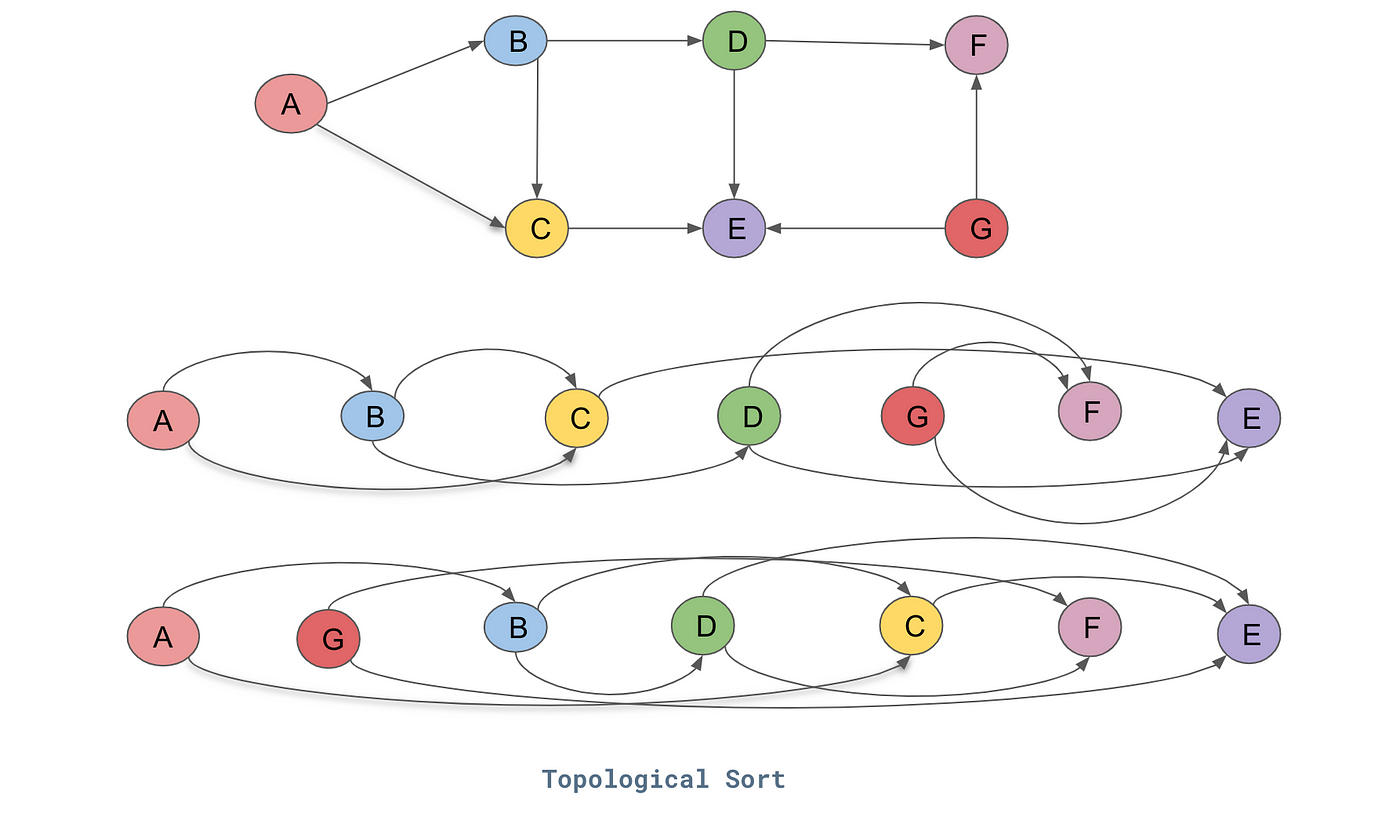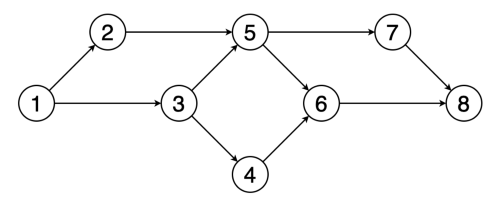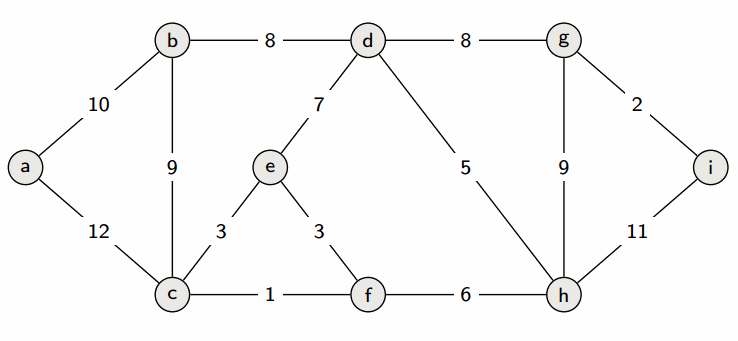# Topological Sort ## and Minimum Spanning Trees --- CS 137 // 2021-10-27 <!--=====================================================================--> ## Administrivia - Assignment 2 should be turned in + ...but let me know if you need more time <!----------------------------------> ## MathCS Board Game Social - Friday, October 29th, 5:00 to 7:00 PM - Third Floor of Collier-Scripps - <!-- .element: class="fragment"--> Halloween costumes encouraged by not required <!--=====================================================================--> # Questions ## ...about anything? <!--=====================================================================--> # DFS and BFS <!-- .slide: data-background="#004477" --> <!--=====================================================================--> ## DFS and BFS Visualization  <!----------------------------------> ## DFS Implementation ```py def dfs(g, start): discovered = {start} stack = [start] while len(stack) > 0: u = stack.pop() print(u) for v in g[u]: if v not in discovered: discovered.add(v) stack.append(v) ``` <!----------------------------------> ## BFS Implementation ```py[1-12|5,12] from collections import deque def bfs(g, start): discovered = {start} queue = deque(discovered) while len(queue) > 0: u = queue.pop() print(u) for v in g[u]: if v not in discovered: discovered.add(v) queue.appendleft(v) ``` <!--=====================================================================--> ## Exercise - A directed graph is **strongly connected** if for every pair of vertices, $u,v$, there is a path starting at $u$ and ending at $v$ <!----------------------------------> ## Idea 1: Run DFS a Bunch 1. For each vertex in the graph... - <!-- .element: class="fragment"--> Run DFS starting from that vertex - <!-- .element: class="fragment"--> Check to make sure that every vertex was discovered - <!-- .element: class="fragment"--> If not, return False 2. <!-- .element: class="fragment"--> Return True --- - <!-- .element: class="fragment"--> What is the runtime complexity of this approach? + <!-- .element: class="fragment"--> $O(n\cdot(n+m))$ - <!-- .element: class="fragment"--> Can we do better? <!----------------------------------> ## Idea 2: Run DFS on $G$ and $G_\text{inv}$ - If we run DFS on the original graph $G$, it will tell us if the start vertex can reach every other vertex - <!-- .element: class="fragment"--> If we **invert** the graph $G$ so that all edges are going the opposite direction, running DFS will tell us if the start vertex **can be reached** from every other vertex <!----------------------------------> ## Idea 2: Pseudocode 1. Create a copy of the graph $G$ with all the edges flipped around going the opposite direction 2. <!-- .element: class="fragment"--> Choose a starting vertex $u$ and run DFS on $u$ in the original graph and in the inverted graph 3. <!-- .element: class="fragment"--> If every vertex was discovered both times, return True, otherwise return False <!--=====================================================================--> # Topological Sort <!-- .slide: data-background="#004477" --> <!--=====================================================================--> ## Prerequisite Graphs - An issue you might be familiar with is writing a schedule to take all the CS requirements in some particular order (four year plan) --- <div class='jekyll-diagrams diagrams graphviz'> <!-- Generated by graphviz version 2.43.0 (0) --> <!-- Title: %3 Pages: 1 --> <svg width="486pt" height="268pt" viewBox="0.00 0.00 486.00 268.00" xmlns="http://www.w3.org/2000/svg" xmlns:xlink="http://www.w3.org/1999/xlink"> <g id="graph0" class="graph" transform="scale(1 1) rotate(0) translate(4 264)"> <title>%3</title> <polygon fill="white" stroke="transparent" points="-4,4 -4,-264 482,-264 482,4 -4,4"/> <!-- cs147 --> <g id="node1" class="node"> <title>cs147</title> <polygon fill="none" stroke="black" points="166,-112 86,-112 86,-74 166,-74 166,-112"/> <text text-anchor="middle" x="126" y="-96.8" font-family="Times,serif" font-size="14.00">CS 147</text> <text text-anchor="middle" x="126" y="-81.8" font-family="Times,serif" font-size="14.00">Graphics</text> </g> <!-- cs167 --> <g id="node2" class="node"> <title>cs167</title> <polygon fill="none" stroke="black" points="286,-186 176,-186 176,-148 286,-148 286,-186"/> <text text-anchor="middle" x="231" y="-170.8" font-family="Times,serif" font-size="14.00">CS 167</text> <text text-anchor="middle" x="231" y="-155.8" font-family="Times,serif" font-size="14.00">Mach. Learn.</text> </g> <!-- cs178 --> <g id="node3" class="node"> <title>cs178</title> <polygon fill="none" stroke="black" points="252,-112 184,-112 184,-74 252,-74 252,-112"/> <text text-anchor="middle" x="218" y="-96.8" font-family="Times,serif" font-size="14.00">CS 178</text> <text text-anchor="middle" x="218" y="-81.8" font-family="Times,serif" font-size="14.00">Cloud</text> </g> <!-- cs65 --> <g id="node4" class="node"> <title>cs65</title> <polygon fill="lightblue" stroke="lightblue" points="260.5,-260 201.5,-260 201.5,-222 260.5,-222 260.5,-260"/> <text text-anchor="middle" x="231" y="-244.8" font-family="Times,serif" font-size="14.00">CS 65</text> <text text-anchor="middle" x="231" y="-229.8" font-family="Times,serif" font-size="14.00">CS I</text> </g> <!-- cs65->cs167 --> <g id="edge1" class="edge"> <title>cs65->cs167</title> <path fill="none" stroke="black" d="M231,-221.83C231,-214.13 231,-204.97 231,-196.42"/> <polygon fill="black" stroke="black" points="234.5,-196.41 231,-186.41 227.5,-196.41 234.5,-196.41"/> </g> <!-- cs66 --> <g id="node5" class="node"> <title>cs66</title> <polygon fill="lightblue" stroke="lightblue" points="157.5,-186 98.5,-186 98.5,-148 157.5,-148 157.5,-186"/> <text text-anchor="middle" x="128" y="-170.8" font-family="Times,serif" font-size="14.00">CS 66</text> <text text-anchor="middle" x="128" y="-155.8" font-family="Times,serif" font-size="14.00">CS II</text> </g> <!-- cs65->cs66 --> <g id="edge2" class="edge"> <title>cs65->cs66</title> <path fill="none" stroke="black" d="M205.01,-221.83C192.08,-212.79 176.28,-201.75 162.36,-192.02"/> <polygon fill="black" stroke="black" points="164.18,-189.02 153.98,-186.16 160.17,-194.76 164.18,-189.02"/> </g> <!-- cs139 --> <g id="node13" class="node"> <title>cs139</title> <polygon fill="lightseagreen" stroke="lightseagreen" points="372,-186 304,-186 304,-148 372,-148 372,-186"/> <text text-anchor="middle" x="338" y="-170.8" font-family="Times,serif" font-size="14.00">CS 139</text> <text text-anchor="middle" x="338" y="-155.8" font-family="Times,serif" font-size="14.00">Theory</text> </g> <!-- cs65->cs139 --> <g id="edge3" class="edge"> <title>cs65->cs139</title> <path fill="none" stroke="black" d="M258,-221.83C271.43,-212.79 287.85,-201.75 302.3,-192.02"/> <polygon fill="black" stroke="black" points="304.67,-194.65 311.01,-186.16 300.76,-188.84 304.67,-194.65"/> </g> <!-- cs66->cs147 --> <g id="edge4" class="edge"> <title>cs66->cs147</title> <path fill="none" stroke="black" d="M127.5,-147.83C127.28,-140.13 127.03,-130.97 126.79,-122.42"/> <polygon fill="black" stroke="black" points="130.29,-122.31 126.51,-112.41 123.29,-122.51 130.29,-122.31"/> </g> <!-- cs66->cs178 --> <g id="edge5" class="edge"> <title>cs66->cs178</title> <path fill="none" stroke="black" d="M150.71,-147.83C161.8,-138.96 175.3,-128.16 187.29,-118.57"/> <polygon fill="black" stroke="black" points="189.67,-121.14 195.3,-112.16 185.3,-115.68 189.67,-121.14"/> </g> <!-- cs146 --> <g id="node6" class="node"> <title>cs146</title> <polygon fill="lightblue" stroke="lightblue" points="329.5,-112 270.5,-112 270.5,-74 329.5,-74 329.5,-112"/> <text text-anchor="middle" x="300" y="-96.8" font-family="Times,serif" font-size="14.00">CS 67</text> <text text-anchor="middle" x="300" y="-81.8" font-family="Times,serif" font-size="14.00">CS III</text> </g> <!-- cs66->cs146 --> <g id="edge6" class="edge"> <title>cs66->cs146</title> <path fill="none" stroke="black" d="M157.72,-152.04C160.84,-150.64 163.98,-149.27 167,-148 208.22,-130.62 219.78,-129.38 261,-112 261.09,-111.96 261.19,-111.92 261.28,-111.88"/> <polygon fill="black" stroke="black" points="262.51,-115.16 270.28,-107.96 259.71,-108.75 262.51,-115.16"/> </g> <!-- cs130 --> <g id="node7" class="node"> <title>cs130</title> <polygon fill="lightblue" stroke="lightblue" points="68,-112 0,-112 0,-74 68,-74 68,-112"/> <text text-anchor="middle" x="34" y="-96.8" font-family="Times,serif" font-size="14.00">CS 130</text> <text text-anchor="middle" x="34" y="-81.8" font-family="Times,serif" font-size="14.00">Org I</text> </g> <!-- cs66->cs130 --> <g id="edge7" class="edge"> <title>cs66->cs130</title> <path fill="none" stroke="black" d="M104.28,-147.83C92.59,-138.88 78.33,-127.96 65.72,-118.3"/> <polygon fill="black" stroke="black" points="67.78,-115.47 57.71,-112.16 63.52,-121.02 67.78,-115.47"/> </g> <!-- cs135 --> <g id="node8" class="node"> <title>cs135</title> <polygon fill="lightblue" stroke="lightblue" points="334,-38 266,-38 266,0 334,0 334,-38"/> <text text-anchor="middle" x="300" y="-22.8" font-family="Times,serif" font-size="14.00">CS 135</text> <text text-anchor="middle" x="300" y="-7.8" font-family="Times,serif" font-size="14.00">PL</text> </g> <!-- cs146->cs135 --> <g id="edge8" class="edge"> <title>cs146->cs135</title> <path fill="none" stroke="black" d="M300,-73.83C300,-66.13 300,-56.97 300,-48.42"/> <polygon fill="black" stroke="black" points="303.5,-48.41 300,-38.41 296.5,-48.41 303.5,-48.41"/> </g> <!-- cs137 --> <g id="node9" class="node"> <title>cs137</title> <polygon fill="lightblue" stroke="lightblue" points="447.5,-38 352.5,-38 352.5,0 447.5,0 447.5,-38"/> <text text-anchor="middle" x="400" y="-22.8" font-family="Times,serif" font-size="14.00">CS 137</text> <text text-anchor="middle" x="400" y="-7.8" font-family="Times,serif" font-size="14.00">Algorithms</text> </g> <!-- cs146->cs137 --> <g id="edge9" class="edge"> <title>cs146->cs137</title> <path fill="none" stroke="black" d="M325.23,-73.83C337.79,-64.79 353.13,-53.75 366.64,-44.02"/> <polygon fill="black" stroke="black" points="368.7,-46.85 374.77,-38.16 364.61,-41.17 368.7,-46.85"/> </g> <!-- cs188 --> <g id="node12" class="node"> <title>cs188</title> <polygon fill="lightblue" stroke="lightblue" points="248,-38 180,-38 180,0 248,0 248,-38"/> <text text-anchor="middle" x="214" y="-22.8" font-family="Times,serif" font-size="14.00">CS 188</text> <text text-anchor="middle" x="214" y="-7.8" font-family="Times,serif" font-size="14.00">SE</text> </g> <!-- cs146->cs188 --> <g id="edge10" class="edge"> <title>cs146->cs188</title> <path fill="none" stroke="black" d="M278.3,-73.83C267.81,-65.05 255.05,-54.37 243.68,-44.85"/> <polygon fill="black" stroke="black" points="245.61,-41.9 235.69,-38.16 241.12,-47.27 245.61,-41.9"/> </g> <!-- math54 --> <g id="node10" class="node"> <title>math54</title> <polygon fill="lightblue" stroke="lightblue" points="397.5,-260 278.5,-260 278.5,-222 397.5,-222 397.5,-260"/> <text text-anchor="middle" x="338" y="-244.8" font-family="Times,serif" font-size="14.00">MATH 54</text> <text text-anchor="middle" x="338" y="-229.8" font-family="Times,serif" font-size="14.00">Discrete Math</text> </g> <!-- math54->cs167 --> <g id="edge11" class="edge"> <title>math54->cs167</title> <path fill="none" stroke="black" d="M311,-221.83C297.57,-212.79 281.15,-201.75 266.7,-192.02"/> <polygon fill="black" stroke="black" points="268.24,-188.84 257.99,-186.16 264.33,-194.65 268.24,-188.84"/> </g> <!-- math54->cs137 --> <g id="edge12" class="edge"> <title>math54->cs137</title> <path fill="none" stroke="black" d="M356.85,-221.72C365.7,-211.98 375.49,-199.28 381,-186 399.86,-140.55 402.06,-82.44 401.41,-48.41"/> <polygon fill="black" stroke="black" points="404.9,-48.15 401.11,-38.25 397.91,-48.35 404.9,-48.15"/> </g> <!-- math54->cs139 --> <g id="edge13" class="edge"> <title>math54->cs139</title> <path fill="none" stroke="black" d="M338,-221.83C338,-214.13 338,-204.97 338,-196.42"/> <polygon fill="black" stroke="black" points="341.5,-196.41 338,-186.41 334.5,-196.41 341.5,-196.41"/> </g> <!-- cs83 --> <g id="node11" class="node"> <title>cs83</title> <polygon fill="lightblue" stroke="lightblue" points="478,-260 416,-260 416,-222 478,-222 478,-260"/> <text text-anchor="middle" x="447" y="-244.8" font-family="Times,serif" font-size="14.00">CS 83</text> <text text-anchor="middle" x="447" y="-229.8" font-family="Times,serif" font-size="14.00">Ethics</text> </g> </g> </svg> </div> <!--=====================================================================--> ## Directed Acyclic Graphs - A dependency graph like this is called a **directed acyclic graph** or **DAG** for short - <!-- .element: class="fragment"--> Why doesn't it make sense for a dependency graph to have a cycle? + <!-- .element: class="fragment"--> Cyclical dependencies means some courses cannot be taken without skipping a prerequisite <!--=====================================================================--> ## Exercise - Write down a sensible ordering for a student to take the following courses --- <div class='jekyll-diagrams diagrams graphviz'> <!-- Generated by graphviz version 2.43.0 (0) --> <!-- Title: %3 Pages: 1 --> <svg width="486pt" height="268pt" viewBox="0.00 0.00 486.00 268.00" xmlns="http://www.w3.org/2000/svg" xmlns:xlink="http://www.w3.org/1999/xlink"> <g id="graph0" class="graph" transform="scale(1 1) rotate(0) translate(4 264)"> <title>%3</title> <polygon fill="white" stroke="transparent" points="-4,4 -4,-264 482,-264 482,4 -4,4"/> <!-- cs147 --> <g id="node1" class="node"> <title>cs147</title> <polygon fill="none" stroke="black" points="166,-112 86,-112 86,-74 166,-74 166,-112"/> <text text-anchor="middle" x="126" y="-96.8" font-family="Times,serif" font-size="14.00">CS 147</text> <text text-anchor="middle" x="126" y="-81.8" font-family="Times,serif" font-size="14.00">Graphics</text> </g> <!-- cs167 --> <g id="node2" class="node"> <title>cs167</title> <polygon fill="none" stroke="black" points="286,-186 176,-186 176,-148 286,-148 286,-186"/> <text text-anchor="middle" x="231" y="-170.8" font-family="Times,serif" font-size="14.00">CS 167</text> <text text-anchor="middle" x="231" y="-155.8" font-family="Times,serif" font-size="14.00">Mach. Learn.</text> </g> <!-- cs178 --> <g id="node3" class="node"> <title>cs178</title> <polygon fill="none" stroke="black" points="252,-112 184,-112 184,-74 252,-74 252,-112"/> <text text-anchor="middle" x="218" y="-96.8" font-family="Times,serif" font-size="14.00">CS 178</text> <text text-anchor="middle" x="218" y="-81.8" font-family="Times,serif" font-size="14.00">Cloud</text> </g> <!-- cs65 --> <g id="node4" class="node"> <title>cs65</title> <polygon fill="lightblue" stroke="lightblue" points="260.5,-260 201.5,-260 201.5,-222 260.5,-222 260.5,-260"/> <text text-anchor="middle" x="231" y="-244.8" font-family="Times,serif" font-size="14.00">CS 65</text> <text text-anchor="middle" x="231" y="-229.8" font-family="Times,serif" font-size="14.00">CS I</text> </g> <!-- cs65->cs167 --> <g id="edge1" class="edge"> <title>cs65->cs167</title> <path fill="none" stroke="black" d="M231,-221.83C231,-214.13 231,-204.97 231,-196.42"/> <polygon fill="black" stroke="black" points="234.5,-196.41 231,-186.41 227.5,-196.41 234.5,-196.41"/> </g> <!-- cs66 --> <g id="node5" class="node"> <title>cs66</title> <polygon fill="lightblue" stroke="lightblue" points="157.5,-186 98.5,-186 98.5,-148 157.5,-148 157.5,-186"/> <text text-anchor="middle" x="128" y="-170.8" font-family="Times,serif" font-size="14.00">CS 66</text> <text text-anchor="middle" x="128" y="-155.8" font-family="Times,serif" font-size="14.00">CS II</text> </g> <!-- cs65->cs66 --> <g id="edge2" class="edge"> <title>cs65->cs66</title> <path fill="none" stroke="black" d="M205.01,-221.83C192.08,-212.79 176.28,-201.75 162.36,-192.02"/> <polygon fill="black" stroke="black" points="164.18,-189.02 153.98,-186.16 160.17,-194.76 164.18,-189.02"/> </g> <!-- cs139 --> <g id="node13" class="node"> <title>cs139</title> <polygon fill="lightseagreen" stroke="lightseagreen" points="372,-186 304,-186 304,-148 372,-148 372,-186"/> <text text-anchor="middle" x="338" y="-170.8" font-family="Times,serif" font-size="14.00">CS 139</text> <text text-anchor="middle" x="338" y="-155.8" font-family="Times,serif" font-size="14.00">Theory</text> </g> <!-- cs65->cs139 --> <g id="edge3" class="edge"> <title>cs65->cs139</title> <path fill="none" stroke="black" d="M258,-221.83C271.43,-212.79 287.85,-201.75 302.3,-192.02"/> <polygon fill="black" stroke="black" points="304.67,-194.65 311.01,-186.16 300.76,-188.84 304.67,-194.65"/> </g> <!-- cs66->cs147 --> <g id="edge4" class="edge"> <title>cs66->cs147</title> <path fill="none" stroke="black" d="M127.5,-147.83C127.28,-140.13 127.03,-130.97 126.79,-122.42"/> <polygon fill="black" stroke="black" points="130.29,-122.31 126.51,-112.41 123.29,-122.51 130.29,-122.31"/> </g> <!-- cs66->cs178 --> <g id="edge5" class="edge"> <title>cs66->cs178</title> <path fill="none" stroke="black" d="M150.71,-147.83C161.8,-138.96 175.3,-128.16 187.29,-118.57"/> <polygon fill="black" stroke="black" points="189.67,-121.14 195.3,-112.16 185.3,-115.68 189.67,-121.14"/> </g> <!-- cs146 --> <g id="node6" class="node"> <title>cs146</title> <polygon fill="lightblue" stroke="lightblue" points="329.5,-112 270.5,-112 270.5,-74 329.5,-74 329.5,-112"/> <text text-anchor="middle" x="300" y="-96.8" font-family="Times,serif" font-size="14.00">CS 67</text> <text text-anchor="middle" x="300" y="-81.8" font-family="Times,serif" font-size="14.00">CS III</text> </g> <!-- cs66->cs146 --> <g id="edge6" class="edge"> <title>cs66->cs146</title> <path fill="none" stroke="black" d="M157.72,-152.04C160.84,-150.64 163.98,-149.27 167,-148 208.22,-130.62 219.78,-129.38 261,-112 261.09,-111.96 261.19,-111.92 261.28,-111.88"/> <polygon fill="black" stroke="black" points="262.51,-115.16 270.28,-107.96 259.71,-108.75 262.51,-115.16"/> </g> <!-- cs130 --> <g id="node7" class="node"> <title>cs130</title> <polygon fill="lightblue" stroke="lightblue" points="68,-112 0,-112 0,-74 68,-74 68,-112"/> <text text-anchor="middle" x="34" y="-96.8" font-family="Times,serif" font-size="14.00">CS 130</text> <text text-anchor="middle" x="34" y="-81.8" font-family="Times,serif" font-size="14.00">Org I</text> </g> <!-- cs66->cs130 --> <g id="edge7" class="edge"> <title>cs66->cs130</title> <path fill="none" stroke="black" d="M104.28,-147.83C92.59,-138.88 78.33,-127.96 65.72,-118.3"/> <polygon fill="black" stroke="black" points="67.78,-115.47 57.71,-112.16 63.52,-121.02 67.78,-115.47"/> </g> <!-- cs135 --> <g id="node8" class="node"> <title>cs135</title> <polygon fill="lightblue" stroke="lightblue" points="334,-38 266,-38 266,0 334,0 334,-38"/> <text text-anchor="middle" x="300" y="-22.8" font-family="Times,serif" font-size="14.00">CS 135</text> <text text-anchor="middle" x="300" y="-7.8" font-family="Times,serif" font-size="14.00">PL</text> </g> <!-- cs146->cs135 --> <g id="edge8" class="edge"> <title>cs146->cs135</title> <path fill="none" stroke="black" d="M300,-73.83C300,-66.13 300,-56.97 300,-48.42"/> <polygon fill="black" stroke="black" points="303.5,-48.41 300,-38.41 296.5,-48.41 303.5,-48.41"/> </g> <!-- cs137 --> <g id="node9" class="node"> <title>cs137</title> <polygon fill="lightblue" stroke="lightblue" points="447.5,-38 352.5,-38 352.5,0 447.5,0 447.5,-38"/> <text text-anchor="middle" x="400" y="-22.8" font-family="Times,serif" font-size="14.00">CS 137</text> <text text-anchor="middle" x="400" y="-7.8" font-family="Times,serif" font-size="14.00">Algorithms</text> </g> <!-- cs146->cs137 --> <g id="edge9" class="edge"> <title>cs146->cs137</title> <path fill="none" stroke="black" d="M325.23,-73.83C337.79,-64.79 353.13,-53.75 366.64,-44.02"/> <polygon fill="black" stroke="black" points="368.7,-46.85 374.77,-38.16 364.61,-41.17 368.7,-46.85"/> </g> <!-- cs188 --> <g id="node12" class="node"> <title>cs188</title> <polygon fill="lightblue" stroke="lightblue" points="248,-38 180,-38 180,0 248,0 248,-38"/> <text text-anchor="middle" x="214" y="-22.8" font-family="Times,serif" font-size="14.00">CS 188</text> <text text-anchor="middle" x="214" y="-7.8" font-family="Times,serif" font-size="14.00">SE</text> </g> <!-- cs146->cs188 --> <g id="edge10" class="edge"> <title>cs146->cs188</title> <path fill="none" stroke="black" d="M278.3,-73.83C267.81,-65.05 255.05,-54.37 243.68,-44.85"/> <polygon fill="black" stroke="black" points="245.61,-41.9 235.69,-38.16 241.12,-47.27 245.61,-41.9"/> </g> <!-- math54 --> <g id="node10" class="node"> <title>math54</title> <polygon fill="lightblue" stroke="lightblue" points="397.5,-260 278.5,-260 278.5,-222 397.5,-222 397.5,-260"/> <text text-anchor="middle" x="338" y="-244.8" font-family="Times,serif" font-size="14.00">MATH 54</text> <text text-anchor="middle" x="338" y="-229.8" font-family="Times,serif" font-size="14.00">Discrete Math</text> </g> <!-- math54->cs167 --> <g id="edge11" class="edge"> <title>math54->cs167</title> <path fill="none" stroke="black" d="M311,-221.83C297.57,-212.79 281.15,-201.75 266.7,-192.02"/> <polygon fill="black" stroke="black" points="268.24,-188.84 257.99,-186.16 264.33,-194.65 268.24,-188.84"/> </g> <!-- math54->cs137 --> <g id="edge12" class="edge"> <title>math54->cs137</title> <path fill="none" stroke="black" d="M356.85,-221.72C365.7,-211.98 375.49,-199.28 381,-186 399.86,-140.55 402.06,-82.44 401.41,-48.41"/> <polygon fill="black" stroke="black" points="404.9,-48.15 401.11,-38.25 397.91,-48.35 404.9,-48.15"/> </g> <!-- math54->cs139 --> <g id="edge13" class="edge"> <title>math54->cs139</title> <path fill="none" stroke="black" d="M338,-221.83C338,-214.13 338,-204.97 338,-196.42"/> <polygon fill="black" stroke="black" points="341.5,-196.41 338,-186.41 334.5,-196.41 341.5,-196.41"/> </g> <!-- cs83 --> <g id="node11" class="node"> <title>cs83</title> <polygon fill="lightblue" stroke="lightblue" points="478,-260 416,-260 416,-222 478,-222 478,-260"/> <text text-anchor="middle" x="447" y="-244.8" font-family="Times,serif" font-size="14.00">CS 83</text> <text text-anchor="middle" x="447" y="-229.8" font-family="Times,serif" font-size="14.00">Ethics</text> </g> </g> </svg> </div> <!--=====================================================================--> ## Topological Ordering  <!--=====================================================================--> ## Topological Sort - An algorithm for finding a topological ordering is called a **topological sort** - <!-- .element: class="fragment"--> Your process for composing a four-year plan is literally a topological sort - <!-- .element: class="fragment"--> The core idea behind the topological sort algorithm is exactly the process you used to order the courses <!----------------------------------> ## Topological Sort  --- 1. Pick a vertex with in-degree zero (no prerequisites) and add it to our output ordering 2. <!-- .element: class="fragment"--> Remove it from the graph 3. <!-- .element: class="fragment"--> Repeat until no vertices are left <!--=====================================================================--> ## Calculating the In-Degrees of Vertices ```py def in_degree(g): """Calculates the in-degree of all vertices""" degree = {u:0 for u in g} for u in g: for v in g[u]: degree[v] += 1 return degree ``` <!--=====================================================================--> ## Topological Sort Implementation ```py def toposort(g): degree = in_degree(g) ready = [u for u in degree if degree[u] == 0] output = [] while len(ready) > 0: u = ready.pop() output.append(u) for v in g[u]: degree[v] -= 1 if degree[v] == 0: ready.append(v) return output ``` <!--=====================================================================--> # Minimum Spanning Trees <!-- .slide: data-background="#004477" --> <!--=====================================================================--> ## Weighted Graphs - Recall that a *weighted graph* has numerical values, called weights, assigned to each edge - Weighted graphs are useful for modeling all sorts of real-world problems + <!-- .element: class="fragment"--> E.g., weights could represent cost of building a power line between two points <div class='jekyll-diagrams diagrams graphviz'> <!-- Generated by graphviz version 2.43.0 (0) --> <!-- Title: dfa Pages: 1 --> <svg width="389pt" height="119pt" viewBox="0.00 0.00 389.00 119.00" xmlns="http://www.w3.org/2000/svg" xmlns:xlink="http://www.w3.org/1999/xlink"> <g id="graph0" class="graph" transform="scale(1 1) rotate(0) translate(4 115)"> <title>dfa</title> <polygon fill="white" stroke="transparent" points="-4,4 -4,-115 385,-115 385,4 -4,4"/> <!-- a --> <g id="node1" class="node"> <title>a</title> <ellipse fill="none" stroke="black" cx="27" cy="-72" rx="27" ry="18"/> <text text-anchor="middle" x="27" y="-68.3" font-family="Times,serif" font-size="14.00">a</text> </g> <!-- b --> <g id="node2" class="node"> <title>b</title> <ellipse fill="none" stroke="black" cx="354" cy="-92" rx="27" ry="18"/> <text text-anchor="middle" x="354" y="-88.3" font-family="Times,serif" font-size="14.00">b</text> </g> <!-- a--b --> <g id="edge1" class="edge"> <title>a--b</title> <path fill="none" stroke="black" d="M51.55,-79.81C58.11,-81.75 65.28,-83.66 72,-85 88.22,-88.25 92.52,-87.58 109,-89 189.3,-95.92 209.44,-97.76 290,-100 298.44,-100.23 300.59,-100.76 309,-100 315.19,-99.44 321.8,-98.45 327.98,-97.35"/> <text text-anchor="middle" x="190.5" y="-99.8" font-family="Times,serif" font-size="14.00">5</text> </g> <!-- c --> <g id="node3" class="node"> <title>c</title> <ellipse fill="none" stroke="black" cx="245" cy="-69" rx="27" ry="18"/> <text text-anchor="middle" x="245" y="-65.3" font-family="Times,serif" font-size="14.00">c</text> </g> <!-- a--c --> <g id="edge2" class="edge"> <title>a--c</title> <path fill="none" stroke="black" d="M54.05,-71.64C95.57,-71.06 176.28,-69.94 217.85,-69.36"/> <text text-anchor="middle" x="136" y="-73.8" font-family="Times,serif" font-size="14.00">7</text> </g> <!-- d --> <g id="node4" class="node"> <title>d</title> <ellipse fill="none" stroke="black" cx="136" cy="-18" rx="27" ry="18"/> <text text-anchor="middle" x="136" y="-14.3" font-family="Times,serif" font-size="14.00">d</text> </g> <!-- a--d --> <g id="edge4" class="edge"> <title>a--d</title> <path fill="none" stroke="black" d="M45.9,-59C53.7,-53.66 63.07,-47.65 72,-43 84.73,-36.37 99.64,-30.38 111.75,-25.93"/> <text text-anchor="middle" x="81.5" y="-46.8" font-family="Times,serif" font-size="14.00">13</text> </g> <!-- c--b --> <g id="edge3" class="edge"> <title>c--b</title> <path fill="none" stroke="black" d="M270.82,-74.33C287.98,-78.02 310.73,-82.91 327.95,-86.61"/> <text text-anchor="middle" x="299.5" y="-84.8" font-family="Times,serif" font-size="14.00">11</text> </g> <!-- d--c --> <g id="edge5" class="edge"> <title>d--c</title> <path fill="none" stroke="black" d="M160.12,-26.18C172.2,-30.71 187.11,-36.68 200,-43 208.29,-47.06 217.1,-52.11 224.65,-56.68"/> <text text-anchor="middle" x="190.5" y="-46.8" font-family="Times,serif" font-size="14.00">17</text> </g> </g> </svg> </div> <!----------------------------------> ## Weighted Graphs - The weights of a graph $G=(V,E)$ can be represented as a function $w:E\rightarrow\mathbb{R}_{>0}$ or as a lookup table - Thus, $w(i,j)$ is a common notation for returning the weight of the edge from vertex $i$ to vertex $j$ <!--=====================================================================--> ## Spanning Trees - Given an undirected, connected, graph $G=(V,E)$, a **spanning tree** is a connected subgraph $T = (V,E')$ with $E'\subseteq E$ with no cycles  <!--=====================================================================--> ## Minimum Spanning Trees - Finding the **minimum spanning tree** (**MST**) is extremely useful for a lot of problems  <!----------------------------------> ## Formal MST Problem - **Input**: A connected, weighted, undirected graph $G = (V,E)$ with weights $w:E\rightarrow\mathbb{R}_{>0}$ - **Output**: a tree $T = (V,E')$ where $E'\subseteq E$ so that $\\sum_{e\\in E'} w(e) is minimized <!--=====================================================================--> ## Exercise - Find a minimum spanning tree  <!--=====================================================================--> # Prim's Algorithm <!-- .slide: data-background="#004477" --> <!--=====================================================================--> ## Prim's Algorithm - Prim's approach to find an MST is **greedy** - <!-- .element: class="fragment"--> The main idea is to build up a partial MST and keep choosing the **cheapest** edge out of the tree that doesn't create a cycle <!----------------------------------> ## Prim's Visualization  <!----------------------------------> ## Prim's Pseudocode 1. <!-- .element: class="fragment"--> Let $x\in V$ be an arbitrary vertex in $G = (V,E)$ 2. <!-- .element: class="fragment"--> Set $S = \\{x\\}$ and $E' = \emptyset$ 3. <!-- .element: class="fragment"--> While $S \ne V$, do the following: 1. <!-- .element: class="fragment"--> Let $(u,v)\in E$ be the cheapest edge satisfying $u\in S$ and $v\not\in S$ 2. <!-- .element: class="fragment"--> Add $(u,v)$ to $E'$ and $v$ to $S$ 4. <!-- .element: class="fragment"--> Return $T = (V,E')$